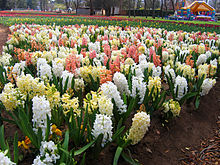- Hyacinthus orientalis
-
Hyacinthus orientalis 
Hyacinthus orientalis, natural form Scientific classification 
Kingdom: Plantae clade: Angiosperms clade: Monocots Order: Asparagales Family: Asparagaceae Subfamily: Scilloideae Genus: Hyacinthus Species: H. orientalis Binomial name Hyacinthus orientalis
L.Hyacinthus orientalis (Common Hyacinth, Garden Hyacinth or Dutch Hyacinth), is a perennial flowering plant, native to southwestern Asia, southern and central Turkey, northwestern Syria, Lebanon and northern Israel. It was introduced to Europe in the 16th century.
It is a bulbous plant, with a 3–7 cm diameter bulb. The leaves are strap-shaped, 15–35 cm long and 1–3 cm broad, with a soft, succulent texture, and produced in a basal whorl. The flowering stem grows to 20–35 cm (rarely to 45 cm) tall, bearing a spike of 2–50 fragrant purple flowers 2–3.5 cm long with a tubular, six-lobed perianth.
In Greek mythology, Hyakinthos was a young man admired by Apollo and Zephyr, but killed by a discus in a jealous fight between the two gods; a flower was allegedly named after him when it sprang from his blood. However, Theophrastus describes both a cultivated and a wild plant called ὑάκινθος (hyakinthos), neither of which are considered to be the modern hyacinth.[1]
Reproduction
The reproduction of the plant in cultivation can be done easily by dividing the newly appeared bulbs from the main plant. In the nature, this method is also used by the Hyacinth but the plant has also specific kind of reproduction by seeds.
The plant is pollinated by different insects such as honey bees. The flowers are very fragrant and attract the insects by rewarding them with nectar.
After flowering the ripening of the seed capsules begins. They are fleshy and spherical structures. When the capsules reach maturity, they get dried and split apart on three parts. Every part has two subdivisions and contains different quantity of seeds. The seeds are black grains with one white elaiosome which size can vary. As it looks since the seeds have such structure, they are dispersed through myrmecochory. Ants find the seeds and take them into their burrows where they use the elaiosome for food. There the seeds can germinate.
Cultivation
It has a long history of cultivation as an ornamental plant, grown across the Mediterranean region, and later France (where it is used in perfumery), the Netherlands (a major centre of cultivation) and elsewhere.
The Garden Hyacinth flowers in the early spring. They grow best in full sun to part shade in well-drained, but not dry, soil. It requires a winter dormancy period, and will only persist in cold-weather regions. It is grown for the clusters of fragrant, brightly-coloured flowers. Over 2,000 cultivars have been selected and named, with flower colour varying from blue, white, pale yellow, pink, red or purple; most cultivars have also been selected for denser flower spikes than the wild type, bearing 40–100 or more flowers on each spike.
H. orientalis contains alkaloids and is toxic if eaten in large quantities. The bulb, however, is the most poisonous part and should not be ingested under any circumstances.
References
Categories:- Scilloideae
- Garden plants
- Flora of Lebanon
Wikimedia Foundation. 2010.

